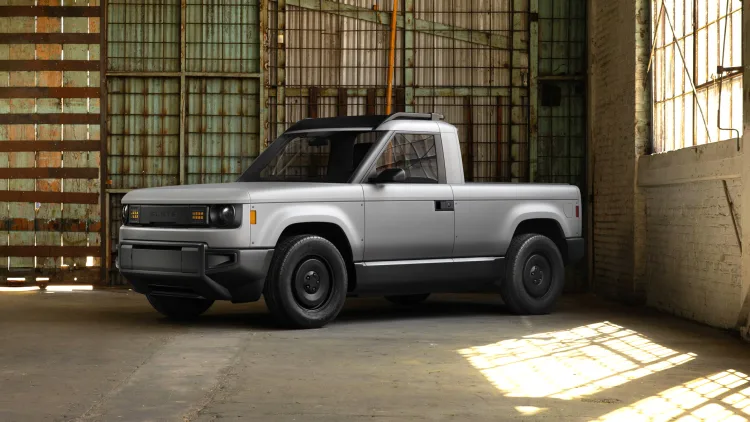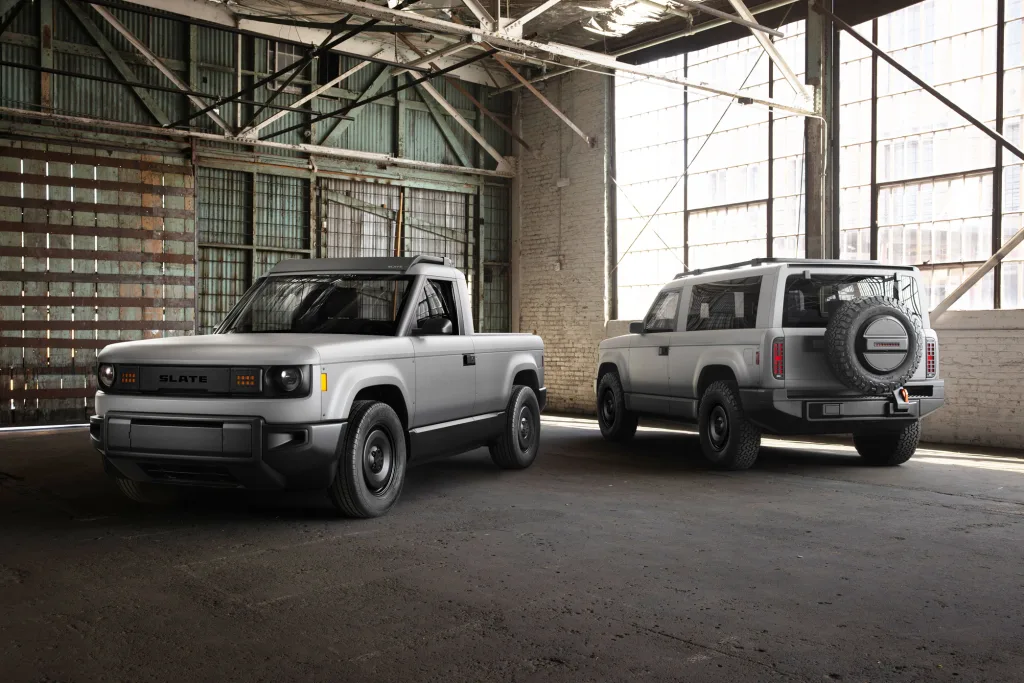
Posted on 04/24/2025 9:52:00 PM PDT by Red Badger
Slate Auto’s new vehicle is designed to make EVs more accessible by making most features optional add-ons. The company says it will start delivering vehicles in 2026.
***************************************************************

A new auto startup is launching with a made-in-America EV that with federal tax credits will cost just $20,000. Backed by Jeff Bezos and Eric Schmidt, Slate Auto says that affordable price is possible because of its pared-down, basic model that can then be customized—and even transformed from a truck into an SUV.
Slate Auto has been in stealth for almost three years, says CEO Chris Barman, who worked as a Chrysler executive until 2017. Based in Michigan, Slate spun out of Re:Build Manufacturing, a company cofounded by Jeff Wilke, former CEO of Amazon’s worldwide consumer business. Slate purports to be “rekindling American industry” with a suite of U.S. industrial businesses, from batteries to composite manufacturing. (Barman is employee number two at Slate; the company now has more than 400 employees.)
Recently, concept vehicles wrapped in ads for fake businesses began appearing on California streets. The company is officially launching today, with refundable vehicle reservations open now for $50. In recent days, the company has put some of its prototype vehicles on California streets, showcasing the possible configurations that will be available.
“When baby drives you crazy, we drive them to sleep,” read one ad for a faux company called CryShare, wrapped around a two-door, boxy SUV. The included website, rockabyerides.com, went to a sign-up page that read “What’s a Slate? Be the first to find out.” Another vehicle with a hatchback cap was covered in ads for cat therapy sessions, and a third, a pickup truck, with ads for a fake human taxidermy service.

The unique marketing campaign was meant to be unlike any traditional vehicle unveiling. “We want to look at things very differently than what traditional automotive has done and what traditional automotive is providing to a consumer,” Barman says. That ethos also applies to the design of the Slate Truck, intended as a basic platform that can be accessorized by any customer.

A blank slate
The Slate Truck will begin as a two-door, two-seat electric pickup, with crank windows and no infotainment system. New cars today can come with lots of built-in features—large screens, heated seats, and so on—but to design Slate, Barman says, it was about “What are really the essentials that should go into a vehicle in order to bring it down to a price point that is affordable?”
Customers will be able to be pick from more than 100 accessories to add on for an extra cost—everything from cup holders to a center console to a single roof crossbar to power windows. Since many people use their phones for music and navigation, the company eliminated the infotainment system to cut costs. Instead, there’s an accompanying app (at no charge) that drivers will be able to use when in the vehicle. If someone wants a radio in their Slate, it’s been designed so that one could be easily installed.
Barman says Slate wants to change the typical process in which a buyer goes to a new- or used-car lot and picks a car, and then has to accept—and pay for—all the features it comes with. “We’ve decoupled that and said to the owner of the vehicle: ‘You choose. You choose if you want a radio. You choose if you want to have heated seats. You choose what you want the color to be,’” she says. “We are putting the power back into the hands of the consumer, so we give them this blank slate, and then they decide.”

The Slate Truck will have exterior panels that are composite, rather than sheet metal. When using sheet metal, companies must have machines that stamp out the pieces; Slate’s composite panels will be made using injection molds. That means the company doesn’t have to invest in a stamping operation or a paint shop—which can run $400 million or more for automakers, Barman says. It also means the EV isn’t limited to a few colorways.
Instead, drivers could put a wrap on it in any color they want. Slate envisions offering customers a wrap kit of die-cut pieces as well as instructional videos so they will be able to do it themselves (the Slate Truck was also designed without any external hardware so that wraps can be applied more easily). Or, the company will offer to prewrap the vehicle before delivery; it plans to have a network of partners in neighborhoods across the country that will be able to perform the installation for customers. (The wrapped vehicles that appeared with fake ads were a nod to this customization element.)

Slate will offer two EV battery options: The standard comes with a range of 150 miles, but customers will be able to upgrade to a battery with an estimated 240 miles of range. The body of the EV will also be alterable, going from a two-door pickup to a five-seat SUV, with upgrades. Barman notes that customers could even do those changes over time, rather than when they first purchase the vehicle.
“Maybe when [someone] first buys it, they’re single or just married, and after a few years they have a family, they can convert it,” she says. “And in doing that, it would cost them maybe $5,000 to make that change. But they don’t have to sell their vehicle and buy a completely new one. It’s a very cost-effective way to allow the vehicle to grow with them as their life changes.”
Offering an affordable EV made in America
Those upgrades would add to the EV’s price. If a customer wants a longer-range battery, a wrap, and to turn the truck into an SUV, those adjustments would cost roughly $10,000. The basic version of the Slate Truck, after the federal EV tax credits are applied, comes to $20,000. “Our passion is this mission to bring an affordable vehicle to the market for the many people who felt that they didn’t have an alternative,” Barman says.
Slate Auto raised at least $111 million in a Series A funding round in 2023 (under the name Re:Car), according to a Securities and Exchange Commission filing. Bezos was among 16 investors in that round, TechCrunch previously reported, adding that Slate closed a Series B funding round last year but has yet to file the paperwork. Slate told Fast Company that the Walter Group, led by Mark Walter, CEO of Guggenheim Partners, is also an investor.
The EV tax credits offer a total of $7,500 back for vehicles that meet specific requirements like being manufactured in the U.S. Though President Trump has said he wants to get rid of the EV tax credits, they are currently still in place. Barman says Slate hopes they remain available to allow more individuals access to its EV. But if the federal credits do go away, she says, “We have a very affordable vehicle priced in the mid $20,000s, so it’s attractive and very competitive at that price point.”
The average price of a new car purchased in the U.S. is above $49,000, according to Kelley Blue Book. The average price of a new EV is even higher, at $55,500. While markets like China have been able to build ultra-affordable EVs, some as low as $10,000, those options haven’t been available for car buyers in the U.S. (though automakers have said that they’re working on affordable options).
With a $50,000 new car, consumers can expect a monthly payment of around $900, Barman says. Even used vehicles, at an average $27,000, can come with monthly payments that exceed $500. Consumers should aim to spend no more than 10% of their monthly take-home pay on car expenses, per Market Watch, but for a new $48,000 car, that means making at least $96,000 a year to afford the $800 monthly payment. In 2023, only 40% of U.S. households made more than $100,000. Barman says monthly payments for a Slate Truck will average $300 to $400.
Slate Auto will build a factory somewhere in the Midwest, in order to be located near the automotive supply center, but it’s still assessing specific locations. “We really are focused on reindustrializing America,” Barman says. (Some car parts will still have to be purchased from abroad because they are not made domestically at all—like the manual window cranks.)
Slate will sell direct to consumer through its website, and the truck will be delivered near customers’ homes; the company plans to set up a nationwide service network as well. Slate plans to bring its EV to market and into consumer hands by the fourth quarter of 2026.
“ Slate Auto’s new vehicle is designed to make EVs more accessible by making most features optional add-ons.”
Add-ons. Like turn signals? Sure, why not; they seem to be an optional add-on on BMW’s and Teslas judging from what I experience on our highways and surface roads.
Kinda looks like what the Tacoma used to be, but isn’t any longer.
I read the headline quickly and thought it said, ... new combustible EV truck.
That would be one of the easiest things to tool up for.

We watched a movie recently made within the last few years using cars from the late 50’s - late 60’s. For some reason the director had the actors crank on the windows like it was some kind of a laborsome chore.
IMO, there’s nothing wrong with crank windows. Our Polaris UTV has them, my 52 Dodge has them.
And it actually looks like a truck, not that rolling rhombus of retardery that the Tesla is.
It probably is.................
If you put a ‘N’ at the end it’s ‘TACOMAN’...........
They actually used to be an ‘add-on’ option!............
Good luck with that. The panels might not rust, but the steel frame, battery box, and other stuff will. You will have to drive without the heater on in order to get any kind of range in the winter, and pulling a trailer is a no-no for range, especially when the trailer weighs nearly as much as the vehicle. '
I had a Samurai in my youth. What a blast. Put the top down and could navigate the back woods due to its narrow body and tight turning radius. This was before quads really hit the market in a big way.
Ford will likely sue.. the SUV looks like a chinese knock off of the bronco.
and ford loves to sue.
If the $7500 credit was not tied to it being a pure EV they would offer a plug in hybrid too. It is very simple engineering for a manufacturer to cut half the 150 mile pack out leaving 75 miles of range, given that 96% of all trips in the USA are under 30 miles -NTHSA and the avg 5 day commute is under 40 miles -DOT a plug in hybrid meets those needs will room to.spare. It is simple for the manufacture to add in a small 1000cc genset spinning a very small high frequency alternator feeding a Silicon carbide rectifier. 1000cc @50kw is a very small 2 cylinder and the 400-1000hz alternator is smaller than a paint can. The 170kw 400hz generator on a 777 engine is the size of a ten gallon paint can and can be held in two hands by a normal sized guy for comparison.
50kw from 1000cc is near its peak BSFC point you get 400-800v DC from the rectifier directly too the pack or motors. Mpg at 40% BFSC to the motors is in the 60 mpg range if you are using 400 watt hours per mile not unreasonable for a EV truck. The Tests Semi at 82,000lb gross weight returns 1700 watt hours per mile for reference the hummer EV is in the 500s.
The cost of the batteries removed are more than the cost of a small motorcycle sized two banger and a directly driven genset it only needs to run at one speed and the SIC rectifier does all the voltage and frequency work in electrons not gears so much cheaper with modern 800V power electronics.
The whole reason they won’t is the sweet sweet uncle sugar money is for pure EV only , that needs to change plug in hybrids fill all the needs. Your daily commute is off cheap grid power my Model 3 at 8 cents per kWh is equal cost per mile to a car getting 30mpg but it needs 43 cents per gallon petrol. The payment on the Model 3 is also half the Volvo it replaces so capex was cheaper from mile one. Having a small onboard generator and a ten gallon tank would let a 60 mpg hybrid add 600 more miles range at will and refill thay 600 in 5 min or less at 100,000 refill points it’s win win.
Someone is going to make a fortune by coming out with a small external genset that is 50-100kw feeding a high frequency alternator feeding a Silicon carbide rectifier that puts put 400-800V DC all the packs any pack cares about is input voltage it’s a matter of software at that point. Every EV could become a hybrid with such a trailer hitch mounted genset. Billions to be made, also offer that genset as a rent able item for road trips. A hitch mount takes 500lbs on a shelf plenty for a small 50kw plus 5-10 gallons in a plastic tank. The only thing needed on the EV side is a female plug that takes the 400-800V to the main pack bus and the software patch to tell the BMS to allow incoming current on that bus to either charge the pack, run the motors or both at the same time. The BMS already does this during regen braking allowing motor current to charge the pack the software only needs to be told to make that bidirectional.
if they make it in a 4x4 they might have a big market for farmers, hunters and country folk.. my Honda Pioneer UTV is over 25K with no windows or heater and it can’t drive you to the supermarket
thats exactly what happened to the last plastic/composite body car. the saturn. people thought the plastic body meant they didn’t have to wash the car in the winter..
Biggest rot boxes around now.
I like the idea of not having an ‘infotainment’ system and having manual windows, even though we don’t know how to make those anymore (plus, I see buttons and levers!). Get rid of the airbags (are you listening Trump?) and allow a hybrid version to be sold, and you’d have a HUGE market - pretty much all of the work trucks only needed for local driving.
Maybe Bezos got a good really good deal on the tooling and stamping parts from an old old Yugo plant.
I wouldn’t buy that piece of crap at any price. Even used, many on S.S. could not afford it. I doubt that most would even want it.
That truck with an in-line 6 and three speed manual transmission would be a winner.
Disclaimer: Opinions posted on Free Republic are those of the individual posters and do not necessarily represent the opinion of Free Republic or its management. All materials posted herein are protected by copyright law and the exemption for fair use of copyrighted works.